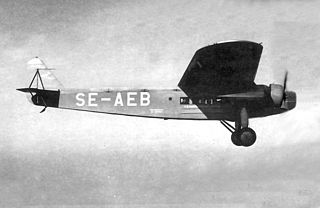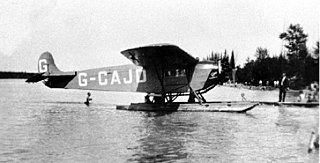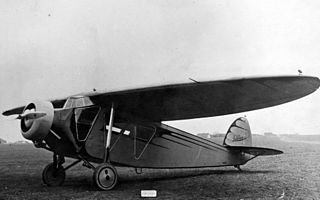
The Douglas DC-3 is a propeller-driven airliner which had a lasting effect on the airline industry in the 1930s/1940s and World War II. It was developed as a larger, improved 14-bed sleeper version of the Douglas DC-2. It is a low-wing metal monoplane with a tailwheel landing gear, powered by two 1,200 hp (890 kW) Pratt & Whitney Twin Wasp radial piston engines. It has a cruise speed of 207 mph (333 km/h), capacity of 21 to 32 passengers or 6,000 lbs of cargo, a range of 1,500 mi (2,400 km), and could operate from short runways.

The Fokker 50 is a turboprop-powered airliner, designed as a refinement of and successor to the highly successful Fokker F27 Friendship. The Fokker 60 is a stretched freighter version of the Fokker 50. Both aircraft were manufactured and supported by Dutch aircraft manufacturer Fokker.

The Fokker F.VII, also known as the Fokker Trimotor, was an airliner produced in the 1920s by the Dutch aircraft manufacturer Fokker, Fokker's American subsidiary Atlantic Aircraft Corporation, and other companies under licence.

The Fokker F26 was an early jet airliner design by the Dutch aircraft manufacturer, Fokker.

The Douglas C-1 was a cargo/transport aircraft produced by the Douglas Aircraft Corporation for the United States Army Air Service starting in 1925.

The Fokker F.VIII was a large twin-engined airliner designed and produced by the Dutch aircraft manufacturer Fokker in the 1920s.

The Fokker Universal was the first aircraft built in the United States that was based on the designs of Dutch-born Anthony Fokker, who had designed aircraft for the Germans during World War I. About half of the 44 Universals that were built between 1926 and 1931 in the United States were used in Canada. Among the famous pilots who flew the Fokker Universal were Punch Dickins and Walter Gilbert.

The Consolidated Model 17 Fleetster was a 1920s American light transport monoplane aircraft built by the Consolidated Aircraft Corporation.

The Fokker F.XX was a 1930s Dutch three-engined airliner designed and built by Fokker. It was the first Fokker design to use an elliptical-section fuselage instead of the traditional square fuselage and the first Fokker aircraft with retractable landing gear.

The Fokker F.XXXVI was a 1930s Dutch four-engined 32-passenger airliner designed and built by Fokker. It was the largest transport designed and built by Fokker.

The Fokker F-14 was an American seven/nine passenger transport aircraft designed by Fokker and built by their Atlantic Aircraft factory in New Jersey.

The Fokker F.II was the first of a long series of commercial aircraft from the Fokker Aircraft Company, flying in 1919. In a biplane age, it presented a distinct clean, high-wing monoplane style that sold successfully across Europe and North America during the development of commercial passenger-carrying aviation.
The Fokker F.XIV was a cargo plane built in the Netherlands in the late 1920s by Fokker. It was a high-wing cantilever monoplane of conventional trimotor layout. The sole example was tested by KLM but never put into service.

The PZL.4 was a Polish three-engine passenger aircraft for 10 passengers, built in PZL factory in 1932, which remained a prototype. It was the first Polish-designed and produced multi-engine plane.

The Lublin R-XI was the Polish passenger plane for 4 passengers, designed in 1930 in the Plage i Laśkiewicz factory in Lublin, that remained a prototype.

The SNCAC NC.211 Cormoran was a large four-engined military transport aircraft for passengers and cargo designed and built by SNCAC from 1945.

The Stearman M-2 Speedmail was a mail-carrier aircraft produced by the Stearman Aircraft Company of Wichita, Kansas. It first flew in January 1929. The Speedmail was a single seat biplane, with two large cargo compartments in place of a front cockpit. The fuselage and tail unit were constructed from welded chrome-moly steel tube faired with wooden formers and fabric covered aft of the pilots cockpit, detachable aluminium alloy panels covered the fuselage forward of the pilots cockpit. The wings were constructed from spruce spars and plywood built-up ribs, all fabric covered. It differed from previous Stearman aircraft by having a tailwheel instead of a tailskid due to its size and weight.

The Northrop Delta was an American single-engined passenger transport aircraft of the 1930s. Closely related to Northrop's Gamma mail plane, 13 were produced by the Northrop Corporation, followed by 19 aircraft built under license by Canadian Vickers Limited.
The Fokker F29 was a conceptual jet airliner design by the Dutch aircraft manufacturer, Fokker.

The Douglas DC-2 is a 14-seat, twin-engined airliner that was produced by the American company Douglas Aircraft Corporation starting in 1934. It competed with the Boeing 247. In 1935, Douglas produced a larger version called the DC-3, which became one of the most successful aircraft in history.

















